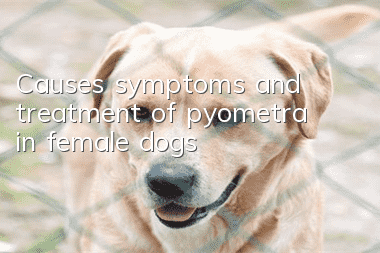Causes, symptoms, and treatment of pyometra in female dogs

Pyometra refers to the accumulation of a large amount of pus in the uterus accompanied by endometrial proliferative inflammation. It is a disease in dogs in the late stages of estrus. It is characterized by abnormal endometrium and inflammatory pathological changes, and accumulation of pus in the uterine cavity. There is pus. According to whether the cervix is open or not, it is divided into two types: atresia and open. Proliferative endometritis, chronic vesicular endometritis, chronic suppurative metritis, uterine abscess, etc. are difficult to distinguish from this disease, so they are collectively called pyometra syndrome.
【Basic information】
Family: Reproductive family
Symptoms: lethargy, anorexia, frequent urination, frequent thirst, vomiting, diarrhea
【Cause of disease】
Canine pyometra syndrome is relatively common among reproductive system diseases. When a large amount of purulent exudate accumulates in the uterus and cannot be discharged, it is called pyometra. It is a disease caused by abnormal endometrial hyperplasia and secondary pathogenic microbial infection. , mostly occurs 2 to 3 months after dogs come into estrus, and is prone to secondary anuria and sepsis.
1. Endocrine factors
Pyometra is mostly due to the long-term effect of high concentrations of progesterone on the endometrium. High concentrations of progesterone can promote endometrial hyperplasia and reduce uterine muscle activity. Due to the stimulation of progesterone, the number and volume of uterine glands increase, and the secretion function is strengthened, which increases the accumulation of fluid in the uterus, providing good conditions for the growth of bacteria; at the same time, progesterone can also inhibit the role of white blood cells in resisting bacterial infection. Therefore, endometritis in dogs can easily lead to pyometra. Pyometra can also be transferred from purulent mastitis and purulent lesions in other locations. This disease can also occur if you have long-term ovarian cysts, ovarian tumors, unicornuate uterus, pseudopregnancy, and long-term stimulation of estrogen or progesterone. The occurrence of pyometra in dogs is also related to the use of progesterone. The disease can also occur in the remaining uterine tissue after ovariohysterectomy. Estrogen can enhance the stimulating effect of progesterone on the uterus. Administration of exogenous estrogens during diestrus may increase the risk of developing pyometra. Therefore, injecting estrogen as a contraceptive method is not recommended.
2. Microbial infection
Certain bacteria in the normal vaginal flora are the most common causes of uterine infection. The bacterium most commonly isolated from cases of pyometra is Escherichia coli. In addition, Staphylococcus, Streptococcus, Pseudomonas, Proteus and other bacteria can also be isolated. When endometrial cystic hyperplasia occurs, the uterine resistance is reduced, making it easier for pathogenic bacteria to invade and multiply, causing endometritis, suppuration, and pyometra, such as mating infections.
3. The estrus cycle is unstable
Older bitches have an increased chance of endometrial infection due to unstable estrous cycles.
4. Others
Mating, false pregnancywait.
【Main Symptoms】
The clinical symptoms of dog disease appear during estrus, usually 1 to 2 months after estrus, or after injection of exogenous progesterone. The sick dogs continue to estrus and bleed, and the vulva is thickened and swollen. The sick dogs show lethargy, anorexia, frequent urination, excessive thirst, vomiting, diarrhea, etc. The abdomen is sensitive to palpation, and some sick dogs have elevated body temperature. When the cervix is open, the vagina discharges purulent secretions, often with blood; when the cervix is atretic, no secretions are seen at the vulva, because the uterine secretions cannot be discharged, causing the uterus to expand, and abdominal distension may occur, sometimes The dilated uterine horns are felt. In the case of abdominal distention, the disease progresses rapidly and can eventually lead to shock and death.
【Diagnostic criteria】
Mainly based on clinical symptoms: loss of appetite or loss of appetite, increased desire to drink, vomiting; B-ultrasound examination: weak echo will appear on the screen, and the uterus will appear as a thick tube or round dark area; blood examination: increased leukocytes and rod-shaped neutrophils Increased cells are one of the important indicators of pyometra.
1. Treatment method Conservative therapy
The treatment principle is: promote the discharge of uterine contents and uterine involution, control and prevent infection, and enhance the body's resistance. For open pyometra, oxytocin or prostate drugs can be injected to promote the elimination of pus, and systemic antibiotics and body fluid replenishment can be used to correct acid-base balance imbalance. In the treatment of atretic pyometra, for patients with open cervix, diethylstilbestrol 0.1 mg or estradiol 0.1 mg (per kilogram of body weight) can be injected intramuscularly to sensitize the uterus, and 2 to 4 hours later, oxytocin 5 ~10U/time or pituitaryin 10~20U/time intramuscular injection, once a day for 3-5 days to promote the discharge of thick juice. Use 10~30ml of pregnancy-stimulating infusion solution or 0.1g of Reifonol, 0.5~1.0g of oxytetracycline and 10~30ml of normal saline to infuse the uterus once every 3 to 5 days. Use it 3 to 5 times in a row to know the uterine secretions. Until it becomes clear and transparent. For cases of cervical atresia, prostaglandin 0.5~0.8 mg/time can be injected intramuscularly or next to the vulva for 5 days. After the cervix is opened and the pus is discharged, treatment will be conducted as an open case.
2. Surgical treatment
Carry out ovarian and hysterectomy surgery as soon as possible. This is currently the best treatment for this disease. It is mainly used for dogs that have little breeding value or that are ineffective in drug treatment. Dogs with elevated body temperature or septicemia should first take antibiotics, add adrenocortical hormone and baking soda to the infusion, and wait until the general condition is stable before undergoing surgery.
3. Systemic drug treatment
Take broad-spectrum antibiotics orally or intramuscularly or intravenously with penicillins, cephalosporins, and aminoglycosides to fight infection throughout the body. At the same time, oral administration of metronidazole or tinidazole tablets or intravenous injection is more effective. Replenish fluids when necessary,Supplement sugar, add VC, dexamethasone, ATP, COA, 5% sodium bicarbonate, 10% potassium chloride, and Anaga to maintain electrolyte balance and correct autopoisoning.
【Prevention and treatment methods】
Sterilization surgery is the best prevention method.
Recommended Good Things
Aineng Pet Odor Eliminating Disinfectant can effectively remove body odor/feces odor and other odor molecules! Effective in treating skin diseases caused by fungi/bacteria! Can kill parvovirus/canine distemper virus/coronavirusetc!
It is edible grade for pets, does not contain fragrances, does not contain chemicals, can be sprayed directly, and is harmless to human pets!
Consultation: 13028809308 (WeChat synchronization)
Scan the QR code on WeChat to enter the purchase
- Which police dog is more powerful? A dog suitable for being a police dog!
- What should you pay attention to when training a red-maned dragon lizard? A must-read for beginners!
- How to train Caucasian dogs to stand
- What should I do if my dog doesn’t take medicine? How can I make my dog take medicine obediently?
- How to train a dog to follow? Train your companion the way the Dog Whisperer does!
- Can Teddy eat watermelon seeds?
- How to train puppies to go to the toilet at designated places
- Do you know the origin of the Dogo?
- The difference between Greyhound and Greyhound_How much does a Greyhound cost and what is its IQ?
- What to do if your dog refuses to take medicine



